Impact of Gender Diversity on Job Satisfaction in Saudi Organizations
VerifiedAdded on 2021/09/21
|22
|5615
|100
Report
AI Summary
This report examines the crucial relationship between gender diversity and job satisfaction within organizations, specifically focusing on the context of Saudi Arabia. The research delves into the existing gender gap in various industries, the underrepresentation of women in managerial positions, and the impact of these factors on employee satisfaction and organizational performance. The study explores the theoretical background of gender diversity, structural approaches to job satisfaction, and the significance of creating inclusive workplaces. The report outlines the research design, including the target demographics, research instruments, ethical considerations, and data analysis methods. The significance of the research lies in its potential to raise awareness among organizations about the benefits of gender diversity, improve recruitment and selection decisions, and promote equal opportunities for both genders. Furthermore, it aims to provide insights for the government of Saudi Arabia to implement policies that address gender discrimination and foster a more equitable society. The report emphasizes the importance of recognizing and utilizing the skills of both men and women to achieve organizational success, highlighting the need for transparent performance management, flexible working practices, and training and development programs.
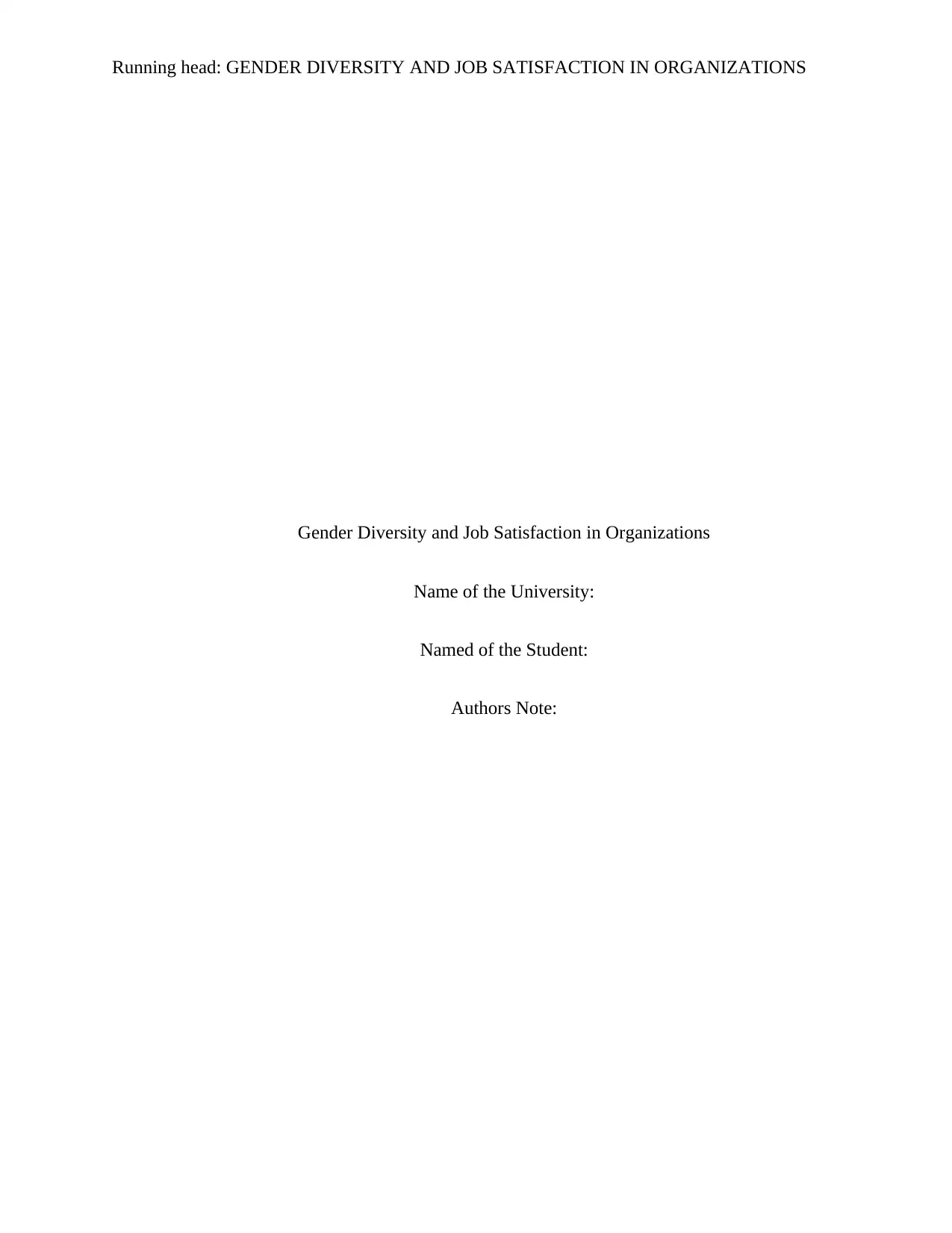
Running head: GENDER DIVERSITY AND JOB SATISFACTION IN ORGANIZATIONS
Gender Diversity and Job Satisfaction in Organizations
Name of the University:
Named of the Student:
Authors Note:
Gender Diversity and Job Satisfaction in Organizations
Name of the University:
Named of the Student:
Authors Note:
Paraphrase This Document
Need a fresh take? Get an instant paraphrase of this document with our AI Paraphraser
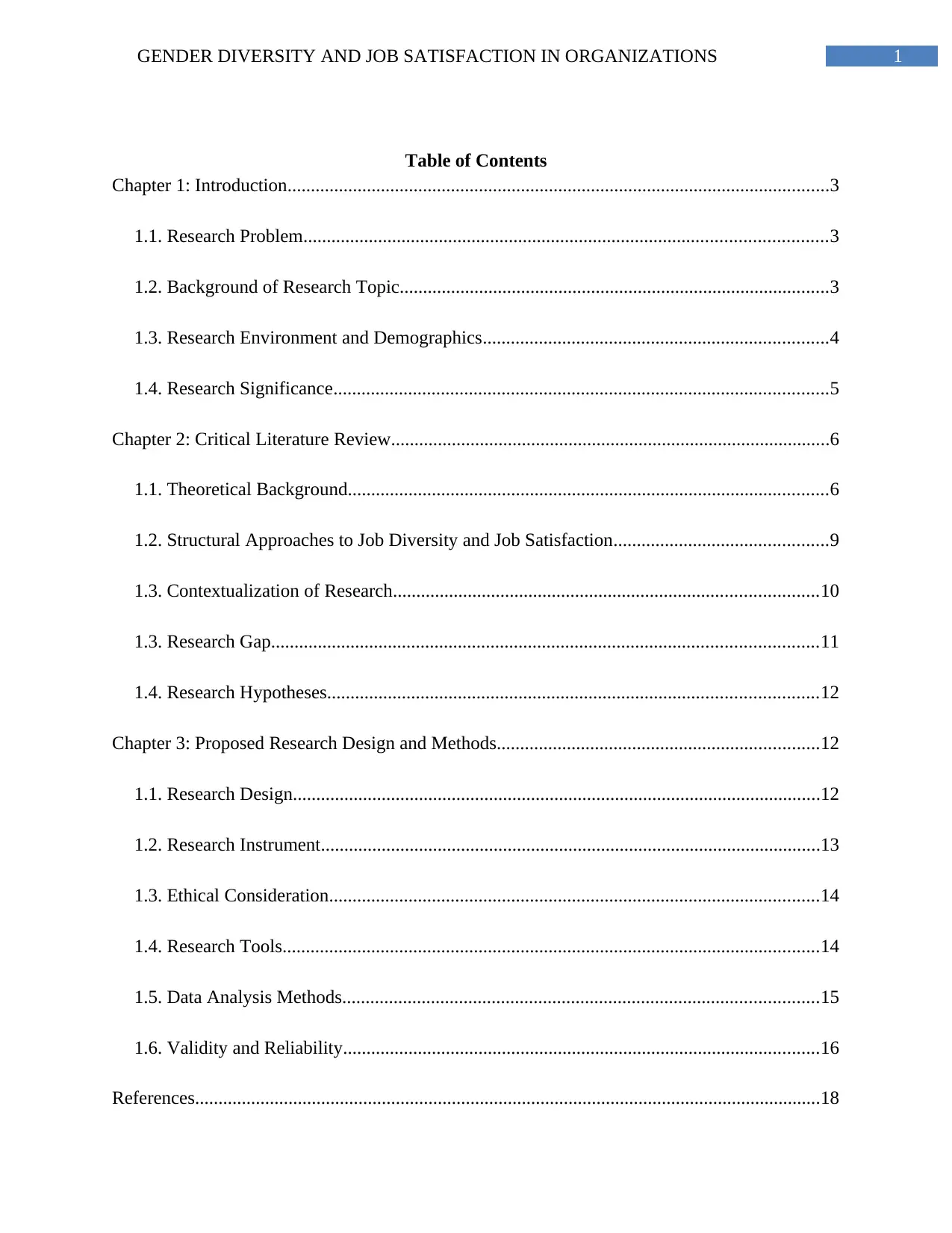
1GENDER DIVERSITY AND JOB SATISFACTION IN ORGANIZATIONS
Table of Contents
Chapter 1: Introduction....................................................................................................................3
1.1. Research Problem................................................................................................................3
1.2. Background of Research Topic............................................................................................3
1.3. Research Environment and Demographics..........................................................................4
1.4. Research Significance..........................................................................................................5
Chapter 2: Critical Literature Review..............................................................................................6
1.1. Theoretical Background.......................................................................................................6
1.2. Structural Approaches to Job Diversity and Job Satisfaction..............................................9
1.3. Contextualization of Research...........................................................................................10
1.3. Research Gap.....................................................................................................................11
1.4. Research Hypotheses.........................................................................................................12
Chapter 3: Proposed Research Design and Methods.....................................................................12
1.1. Research Design.................................................................................................................12
1.2. Research Instrument...........................................................................................................13
1.3. Ethical Consideration.........................................................................................................14
1.4. Research Tools...................................................................................................................14
1.5. Data Analysis Methods......................................................................................................15
1.6. Validity and Reliability......................................................................................................16
References......................................................................................................................................18
Table of Contents
Chapter 1: Introduction....................................................................................................................3
1.1. Research Problem................................................................................................................3
1.2. Background of Research Topic............................................................................................3
1.3. Research Environment and Demographics..........................................................................4
1.4. Research Significance..........................................................................................................5
Chapter 2: Critical Literature Review..............................................................................................6
1.1. Theoretical Background.......................................................................................................6
1.2. Structural Approaches to Job Diversity and Job Satisfaction..............................................9
1.3. Contextualization of Research...........................................................................................10
1.3. Research Gap.....................................................................................................................11
1.4. Research Hypotheses.........................................................................................................12
Chapter 3: Proposed Research Design and Methods.....................................................................12
1.1. Research Design.................................................................................................................12
1.2. Research Instrument...........................................................................................................13
1.3. Ethical Consideration.........................................................................................................14
1.4. Research Tools...................................................................................................................14
1.5. Data Analysis Methods......................................................................................................15
1.6. Validity and Reliability......................................................................................................16
References......................................................................................................................................18
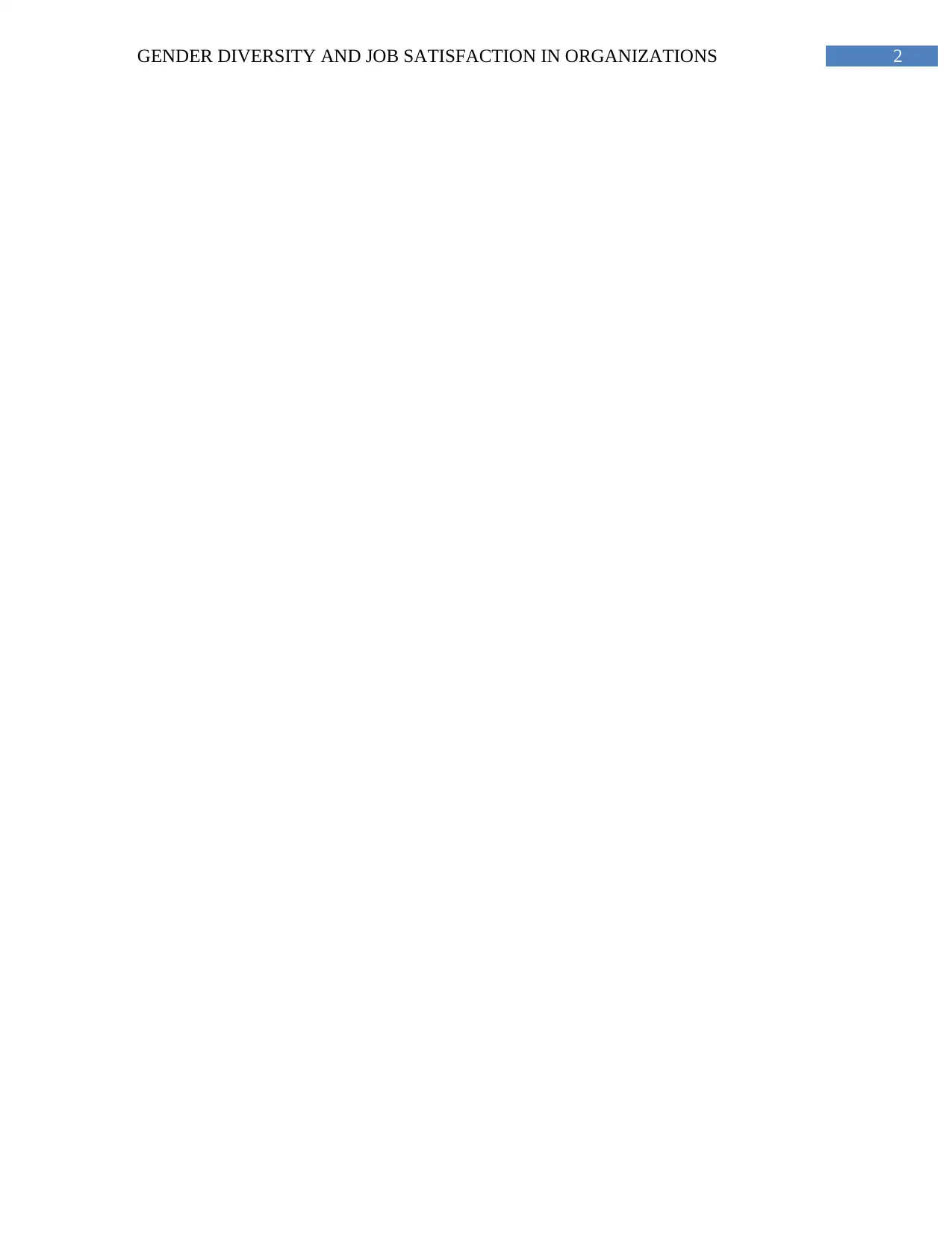
2GENDER DIVERSITY AND JOB SATISFACTION IN ORGANIZATIONS
⊘ This is a preview!⊘
Do you want full access?
Subscribe today to unlock all pages.

Trusted by 1+ million students worldwide

3GENDER DIVERSITY AND JOB SATISFACTION IN ORGANIZATIONS
Chapter 1: Introduction
1.1. Research Problem
Gender diversity in workplace is a problem, which has been addressed by numerous
international institutes and several researches have been conducted. The traditional business
organizations provide men with the prominence to manage boardroom representation as well as
corporate responsibilities. With numerous legal and social reforms, women have been provided
with equal job opportunities and education (Madsen and Nielsen 2017). By accomplishing higher
educational levels as well as professionalism, women would have the similar performance ability
like men.
Despite the fact that there is an upward movement in women accomplishing career
success, some empirical researches have been carried out for identifying the real impact of
providing equal career opportunity for both genders in the context of Saudi Arabia. Hence,
conducting a research on this issue is significant, since it could result in awareness for other
institutions to gain an understanding of benefits of enforcing gender diversity in their
organizational culture.
1.2. Background of Research Topic
Out of the overall population of Saudi Arabia, the female population comprises of
35.90% of the overall population, while the male population has been 64.10% of the total
population of the nation (Tanwar and Prasad 2016). However, the number of women in high
managerial positions is insignificant. Both professional men and women have high competency
levels; however, proper recognition is not provided to women for their skills. If the organizations
Chapter 1: Introduction
1.1. Research Problem
Gender diversity in workplace is a problem, which has been addressed by numerous
international institutes and several researches have been conducted. The traditional business
organizations provide men with the prominence to manage boardroom representation as well as
corporate responsibilities. With numerous legal and social reforms, women have been provided
with equal job opportunities and education (Madsen and Nielsen 2017). By accomplishing higher
educational levels as well as professionalism, women would have the similar performance ability
like men.
Despite the fact that there is an upward movement in women accomplishing career
success, some empirical researches have been carried out for identifying the real impact of
providing equal career opportunity for both genders in the context of Saudi Arabia. Hence,
conducting a research on this issue is significant, since it could result in awareness for other
institutions to gain an understanding of benefits of enforcing gender diversity in their
organizational culture.
1.2. Background of Research Topic
Out of the overall population of Saudi Arabia, the female population comprises of
35.90% of the overall population, while the male population has been 64.10% of the total
population of the nation (Tanwar and Prasad 2016). However, the number of women in high
managerial positions is insignificant. Both professional men and women have high competency
levels; however, proper recognition is not provided to women for their skills. If the organizations
Paraphrase This Document
Need a fresh take? Get an instant paraphrase of this document with our AI Paraphraser
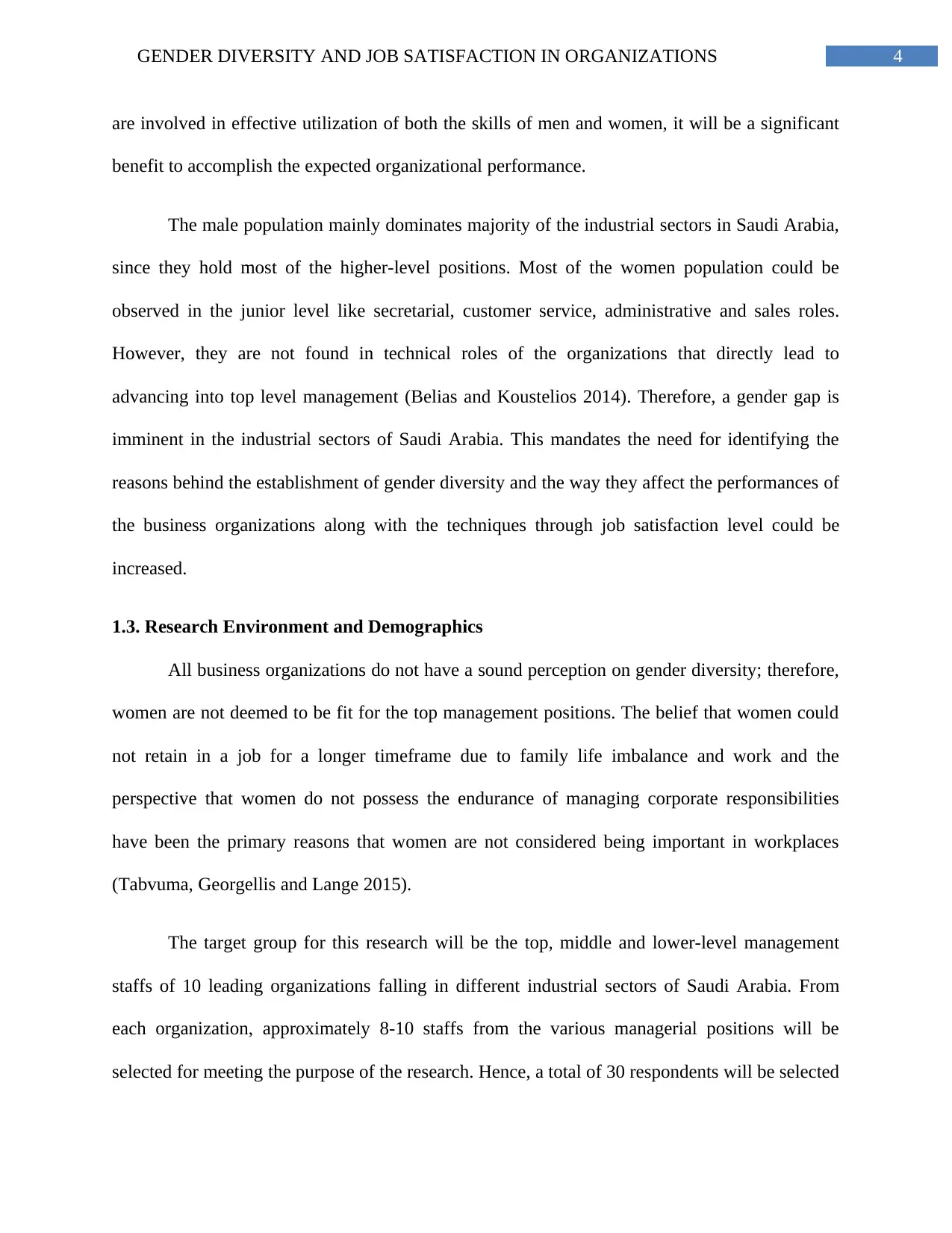
4GENDER DIVERSITY AND JOB SATISFACTION IN ORGANIZATIONS
are involved in effective utilization of both the skills of men and women, it will be a significant
benefit to accomplish the expected organizational performance.
The male population mainly dominates majority of the industrial sectors in Saudi Arabia,
since they hold most of the higher-level positions. Most of the women population could be
observed in the junior level like secretarial, customer service, administrative and sales roles.
However, they are not found in technical roles of the organizations that directly lead to
advancing into top level management (Belias and Koustelios 2014). Therefore, a gender gap is
imminent in the industrial sectors of Saudi Arabia. This mandates the need for identifying the
reasons behind the establishment of gender diversity and the way they affect the performances of
the business organizations along with the techniques through job satisfaction level could be
increased.
1.3. Research Environment and Demographics
All business organizations do not have a sound perception on gender diversity; therefore,
women are not deemed to be fit for the top management positions. The belief that women could
not retain in a job for a longer timeframe due to family life imbalance and work and the
perspective that women do not possess the endurance of managing corporate responsibilities
have been the primary reasons that women are not considered being important in workplaces
(Tabvuma, Georgellis and Lange 2015).
The target group for this research will be the top, middle and lower-level management
staffs of 10 leading organizations falling in different industrial sectors of Saudi Arabia. From
each organization, approximately 8-10 staffs from the various managerial positions will be
selected for meeting the purpose of the research. Hence, a total of 30 respondents will be selected
are involved in effective utilization of both the skills of men and women, it will be a significant
benefit to accomplish the expected organizational performance.
The male population mainly dominates majority of the industrial sectors in Saudi Arabia,
since they hold most of the higher-level positions. Most of the women population could be
observed in the junior level like secretarial, customer service, administrative and sales roles.
However, they are not found in technical roles of the organizations that directly lead to
advancing into top level management (Belias and Koustelios 2014). Therefore, a gender gap is
imminent in the industrial sectors of Saudi Arabia. This mandates the need for identifying the
reasons behind the establishment of gender diversity and the way they affect the performances of
the business organizations along with the techniques through job satisfaction level could be
increased.
1.3. Research Environment and Demographics
All business organizations do not have a sound perception on gender diversity; therefore,
women are not deemed to be fit for the top management positions. The belief that women could
not retain in a job for a longer timeframe due to family life imbalance and work and the
perspective that women do not possess the endurance of managing corporate responsibilities
have been the primary reasons that women are not considered being important in workplaces
(Tabvuma, Georgellis and Lange 2015).
The target group for this research will be the top, middle and lower-level management
staffs of 10 leading organizations falling in different industrial sectors of Saudi Arabia. From
each organization, approximately 8-10 staffs from the various managerial positions will be
selected for meeting the purpose of the research. Hence, a total of 30 respondents will be selected

5GENDER DIVERSITY AND JOB SATISFACTION IN ORGANIZATIONS
to carry out the survey process of the study. Questionnaire will be provided to the participants
via e-mail so that sound knowledge could be gathered regarding experiences and opinions on
discrimination issues as well as gender diversity. Thus, the research environment and
demographics will provide an overview of the organizational benefits at the time of establishing
gender diversity in workplaces.
1.4. Research Significance
The research will be highly significant for different types of business organizations
regardless of their size, nature and industrial sectors. It will generate awareness regarding how
recruiting the talents of both genders could have positive effects on the organizations from
financial perspective as well as psychological perspective (Schwab et al. 2016). This evaluation
of information could be utilized further for undertaking better recruitment as well as selection
decisions along with providing equal opportunity for both the genders. The conventional gender
stereotyping will not be considered in this research, since it emphasizes on the benefits obtained
by recruiting a diversified pool of talents.
For ensuring sustainable variations, all the managers of the business organizations are
required to possess considerable awareness of the needs and challenges in order to develop the
female staffs (Ward and Forker 2017). They are required to possess the ability so that they could
practice transparent performance management, flexible working practices along with sound
training and development, when necessary. By using this research, the government of Saudi
Arabia could lay stress on regulating equal opportunity for the male and female workers in
different types of business organizations. Based on the outcomes, it could undertake appropriate
measures so that gender discrimination could be abolished from the society of the nation.
to carry out the survey process of the study. Questionnaire will be provided to the participants
via e-mail so that sound knowledge could be gathered regarding experiences and opinions on
discrimination issues as well as gender diversity. Thus, the research environment and
demographics will provide an overview of the organizational benefits at the time of establishing
gender diversity in workplaces.
1.4. Research Significance
The research will be highly significant for different types of business organizations
regardless of their size, nature and industrial sectors. It will generate awareness regarding how
recruiting the talents of both genders could have positive effects on the organizations from
financial perspective as well as psychological perspective (Schwab et al. 2016). This evaluation
of information could be utilized further for undertaking better recruitment as well as selection
decisions along with providing equal opportunity for both the genders. The conventional gender
stereotyping will not be considered in this research, since it emphasizes on the benefits obtained
by recruiting a diversified pool of talents.
For ensuring sustainable variations, all the managers of the business organizations are
required to possess considerable awareness of the needs and challenges in order to develop the
female staffs (Ward and Forker 2017). They are required to possess the ability so that they could
practice transparent performance management, flexible working practices along with sound
training and development, when necessary. By using this research, the government of Saudi
Arabia could lay stress on regulating equal opportunity for the male and female workers in
different types of business organizations. Based on the outcomes, it could undertake appropriate
measures so that gender discrimination could be abolished from the society of the nation.
⊘ This is a preview!⊘
Do you want full access?
Subscribe today to unlock all pages.

Trusted by 1+ million students worldwide

6GENDER DIVERSITY AND JOB SATISFACTION IN ORGANIZATIONS
Chapter 2: Critical Literature Review
1.1. Theoretical Background
Rodriguez et al. (2016) considered that gender diversity refers to organizational activities
employing people coming from distinct parts of the world. Under the gender diversity activity
within organizations human resource management, the organization gets to employ people
through maintaining equality among genders. Such diversity aspect facilitates equal work
distribution along with fair representation among all the enders. Nguyen, Locke and Reddy
(2015) added that in current environment the rate of employee dissatisfaction is increasing with
an increased speed for the reason that the human resource manager is unable to understand needs
of employees. An increased focus is also on maintaining healthy working environment as well.
Decreasing job satisfaction makes the companies bear heavy loss regarding knowledge,
resources along with manpower. Ozturk and Tatli (2016) revealed that the critical literature
review is greatly focused on the gender diversity aspects along with its importance on job
satisfaction of employees. In an organization, it is also considered that one section is weaker in
comparison to another section that is stronger at the workplace. Certain actions initiated by the
organization’s management are also implemented in order to satisfy the majority areas of the
companies because of which they obtain increased job satisfaction in the market. Rao and Tilt
(2016) added that at the time of conflicts, the major fraction of the society is highly prone to get
insulted in the job position. For this reason, considering such aspects it can be clearly observed
that there is an increased requirement of equality or else some groups in the organization might
feel dissatisfaction or feel avoided. It was also gathered that effective diversity management that
strongly leads to positive organizational effectiveness.
Chapter 2: Critical Literature Review
1.1. Theoretical Background
Rodriguez et al. (2016) considered that gender diversity refers to organizational activities
employing people coming from distinct parts of the world. Under the gender diversity activity
within organizations human resource management, the organization gets to employ people
through maintaining equality among genders. Such diversity aspect facilitates equal work
distribution along with fair representation among all the enders. Nguyen, Locke and Reddy
(2015) added that in current environment the rate of employee dissatisfaction is increasing with
an increased speed for the reason that the human resource manager is unable to understand needs
of employees. An increased focus is also on maintaining healthy working environment as well.
Decreasing job satisfaction makes the companies bear heavy loss regarding knowledge,
resources along with manpower. Ozturk and Tatli (2016) revealed that the critical literature
review is greatly focused on the gender diversity aspects along with its importance on job
satisfaction of employees. In an organization, it is also considered that one section is weaker in
comparison to another section that is stronger at the workplace. Certain actions initiated by the
organization’s management are also implemented in order to satisfy the majority areas of the
companies because of which they obtain increased job satisfaction in the market. Rao and Tilt
(2016) added that at the time of conflicts, the major fraction of the society is highly prone to get
insulted in the job position. For this reason, considering such aspects it can be clearly observed
that there is an increased requirement of equality or else some groups in the organization might
feel dissatisfaction or feel avoided. It was also gathered that effective diversity management that
strongly leads to positive organizational effectiveness.
Paraphrase This Document
Need a fresh take? Get an instant paraphrase of this document with our AI Paraphraser
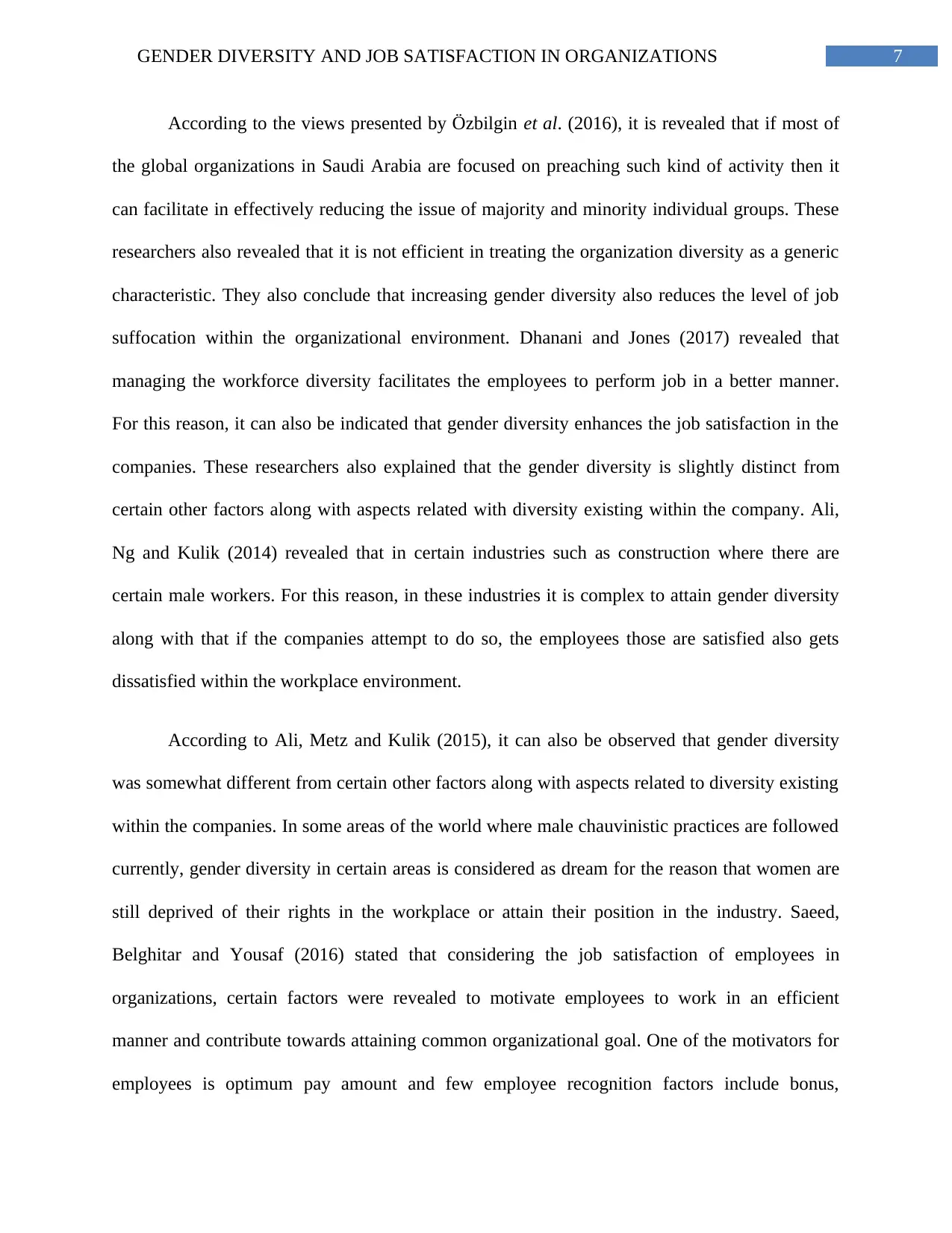
7GENDER DIVERSITY AND JOB SATISFACTION IN ORGANIZATIONS
According to the views presented by Özbilgin et al. (2016), it is revealed that if most of
the global organizations in Saudi Arabia are focused on preaching such kind of activity then it
can facilitate in effectively reducing the issue of majority and minority individual groups. These
researchers also revealed that it is not efficient in treating the organization diversity as a generic
characteristic. They also conclude that increasing gender diversity also reduces the level of job
suffocation within the organizational environment. Dhanani and Jones (2017) revealed that
managing the workforce diversity facilitates the employees to perform job in a better manner.
For this reason, it can also be indicated that gender diversity enhances the job satisfaction in the
companies. These researchers also explained that the gender diversity is slightly distinct from
certain other factors along with aspects related with diversity existing within the company. Ali,
Ng and Kulik (2014) revealed that in certain industries such as construction where there are
certain male workers. For this reason, in these industries it is complex to attain gender diversity
along with that if the companies attempt to do so, the employees those are satisfied also gets
dissatisfied within the workplace environment.
According to Ali, Metz and Kulik (2015), it can also be observed that gender diversity
was somewhat different from certain other factors along with aspects related to diversity existing
within the companies. In some areas of the world where male chauvinistic practices are followed
currently, gender diversity in certain areas is considered as dream for the reason that women are
still deprived of their rights in the workplace or attain their position in the industry. Saeed,
Belghitar and Yousaf (2016) stated that considering the job satisfaction of employees in
organizations, certain factors were revealed to motivate employees to work in an efficient
manner and contribute towards attaining common organizational goal. One of the motivators for
employees is optimum pay amount and few employee recognition factors include bonus,
According to the views presented by Özbilgin et al. (2016), it is revealed that if most of
the global organizations in Saudi Arabia are focused on preaching such kind of activity then it
can facilitate in effectively reducing the issue of majority and minority individual groups. These
researchers also revealed that it is not efficient in treating the organization diversity as a generic
characteristic. They also conclude that increasing gender diversity also reduces the level of job
suffocation within the organizational environment. Dhanani and Jones (2017) revealed that
managing the workforce diversity facilitates the employees to perform job in a better manner.
For this reason, it can also be indicated that gender diversity enhances the job satisfaction in the
companies. These researchers also explained that the gender diversity is slightly distinct from
certain other factors along with aspects related with diversity existing within the company. Ali,
Ng and Kulik (2014) revealed that in certain industries such as construction where there are
certain male workers. For this reason, in these industries it is complex to attain gender diversity
along with that if the companies attempt to do so, the employees those are satisfied also gets
dissatisfied within the workplace environment.
According to Ali, Metz and Kulik (2015), it can also be observed that gender diversity
was somewhat different from certain other factors along with aspects related to diversity existing
within the companies. In some areas of the world where male chauvinistic practices are followed
currently, gender diversity in certain areas is considered as dream for the reason that women are
still deprived of their rights in the workplace or attain their position in the industry. Saeed,
Belghitar and Yousaf (2016) stated that considering the job satisfaction of employees in
organizations, certain factors were revealed to motivate employees to work in an efficient
manner and contribute towards attaining common organizational goal. One of the motivators for
employees is optimum pay amount and few employee recognition factors include bonus,
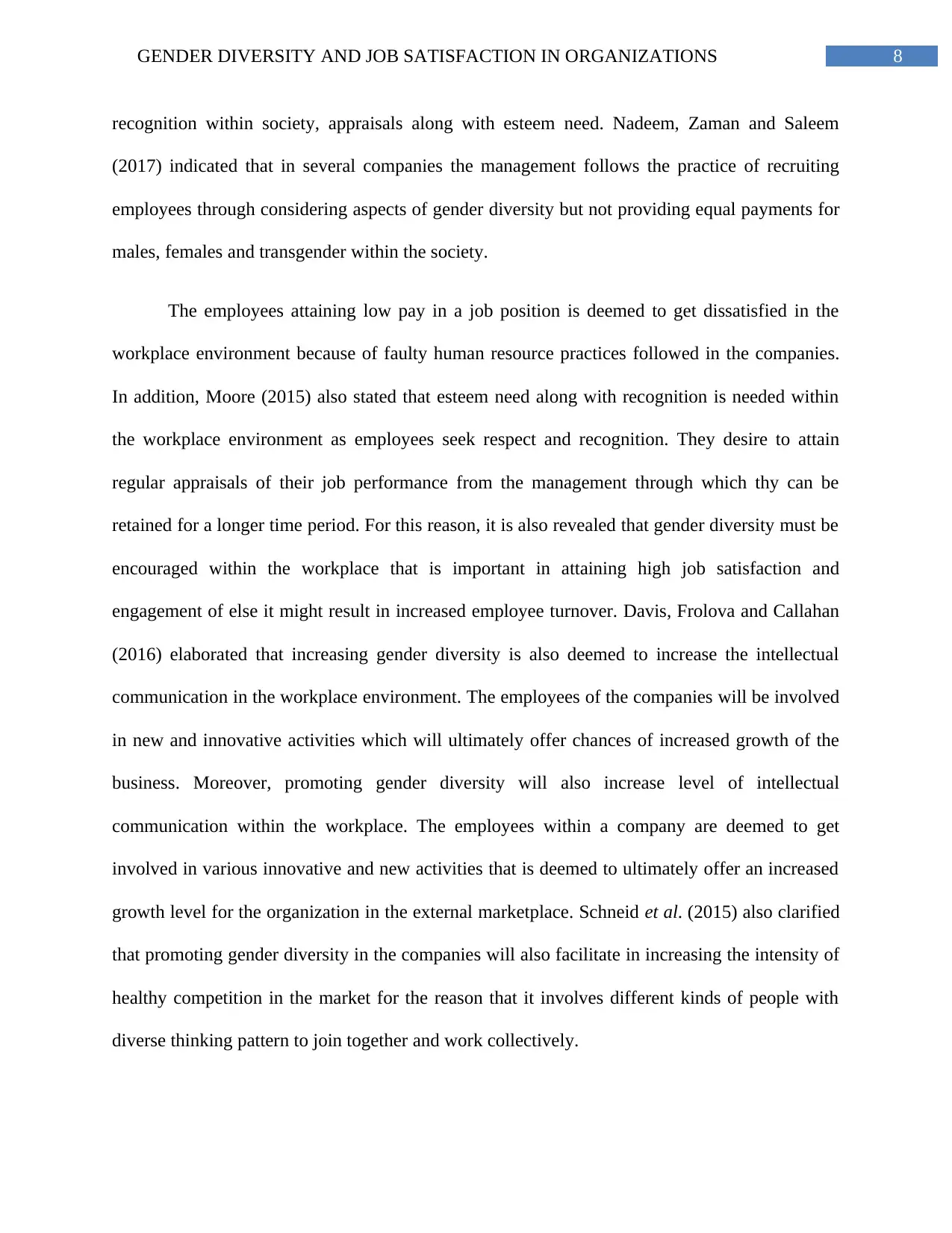
8GENDER DIVERSITY AND JOB SATISFACTION IN ORGANIZATIONS
recognition within society, appraisals along with esteem need. Nadeem, Zaman and Saleem
(2017) indicated that in several companies the management follows the practice of recruiting
employees through considering aspects of gender diversity but not providing equal payments for
males, females and transgender within the society.
The employees attaining low pay in a job position is deemed to get dissatisfied in the
workplace environment because of faulty human resource practices followed in the companies.
In addition, Moore (2015) also stated that esteem need along with recognition is needed within
the workplace environment as employees seek respect and recognition. They desire to attain
regular appraisals of their job performance from the management through which thy can be
retained for a longer time period. For this reason, it is also revealed that gender diversity must be
encouraged within the workplace that is important in attaining high job satisfaction and
engagement of else it might result in increased employee turnover. Davis, Frolova and Callahan
(2016) elaborated that increasing gender diversity is also deemed to increase the intellectual
communication in the workplace environment. The employees of the companies will be involved
in new and innovative activities which will ultimately offer chances of increased growth of the
business. Moreover, promoting gender diversity will also increase level of intellectual
communication within the workplace. The employees within a company are deemed to get
involved in various innovative and new activities that is deemed to ultimately offer an increased
growth level for the organization in the external marketplace. Schneid et al. (2015) also clarified
that promoting gender diversity in the companies will also facilitate in increasing the intensity of
healthy competition in the market for the reason that it involves different kinds of people with
diverse thinking pattern to join together and work collectively.
recognition within society, appraisals along with esteem need. Nadeem, Zaman and Saleem
(2017) indicated that in several companies the management follows the practice of recruiting
employees through considering aspects of gender diversity but not providing equal payments for
males, females and transgender within the society.
The employees attaining low pay in a job position is deemed to get dissatisfied in the
workplace environment because of faulty human resource practices followed in the companies.
In addition, Moore (2015) also stated that esteem need along with recognition is needed within
the workplace environment as employees seek respect and recognition. They desire to attain
regular appraisals of their job performance from the management through which thy can be
retained for a longer time period. For this reason, it is also revealed that gender diversity must be
encouraged within the workplace that is important in attaining high job satisfaction and
engagement of else it might result in increased employee turnover. Davis, Frolova and Callahan
(2016) elaborated that increasing gender diversity is also deemed to increase the intellectual
communication in the workplace environment. The employees of the companies will be involved
in new and innovative activities which will ultimately offer chances of increased growth of the
business. Moreover, promoting gender diversity will also increase level of intellectual
communication within the workplace. The employees within a company are deemed to get
involved in various innovative and new activities that is deemed to ultimately offer an increased
growth level for the organization in the external marketplace. Schneid et al. (2015) also clarified
that promoting gender diversity in the companies will also facilitate in increasing the intensity of
healthy competition in the market for the reason that it involves different kinds of people with
diverse thinking pattern to join together and work collectively.
⊘ This is a preview!⊘
Do you want full access?
Subscribe today to unlock all pages.

Trusted by 1+ million students worldwide
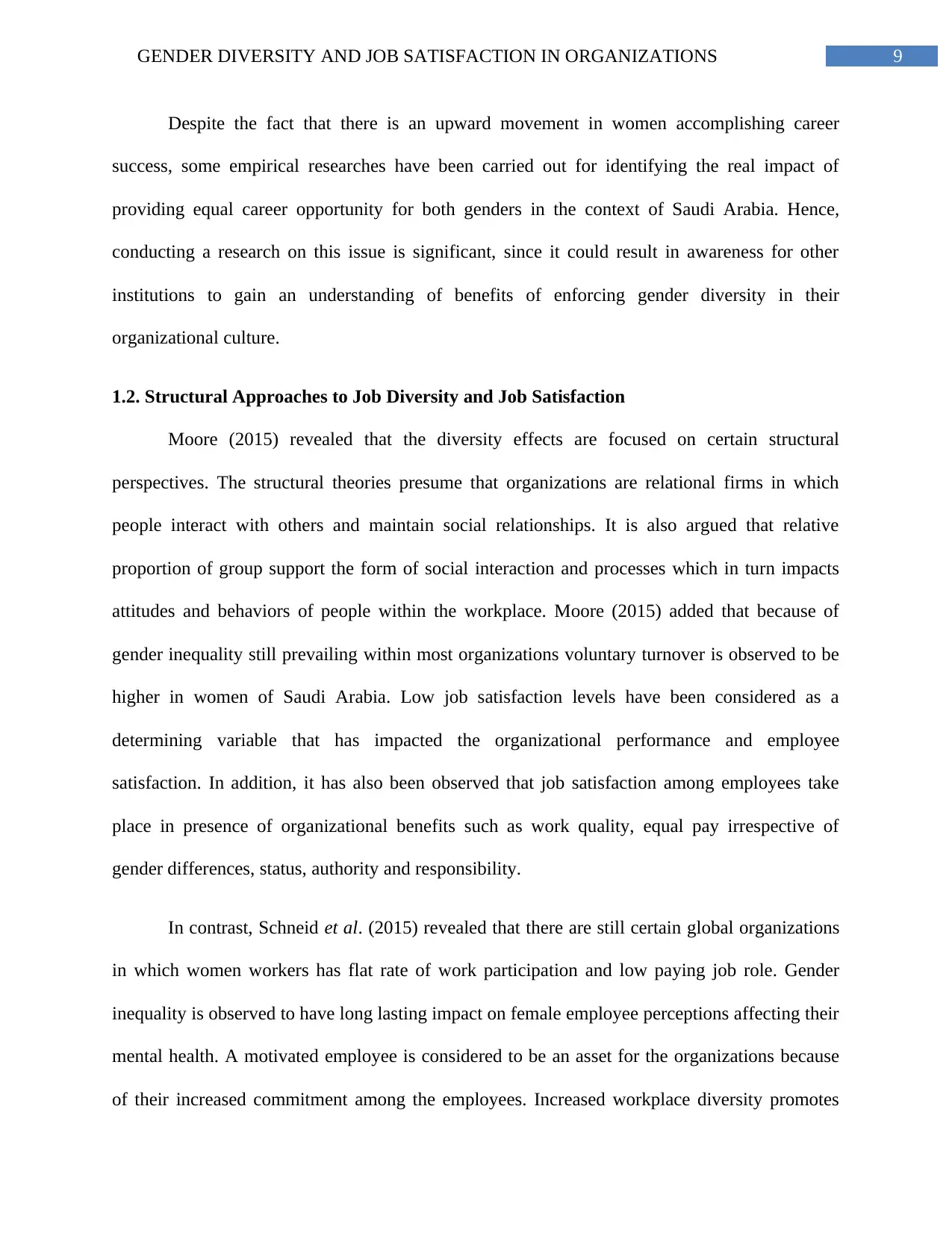
9GENDER DIVERSITY AND JOB SATISFACTION IN ORGANIZATIONS
Despite the fact that there is an upward movement in women accomplishing career
success, some empirical researches have been carried out for identifying the real impact of
providing equal career opportunity for both genders in the context of Saudi Arabia. Hence,
conducting a research on this issue is significant, since it could result in awareness for other
institutions to gain an understanding of benefits of enforcing gender diversity in their
organizational culture.
1.2. Structural Approaches to Job Diversity and Job Satisfaction
Moore (2015) revealed that the diversity effects are focused on certain structural
perspectives. The structural theories presume that organizations are relational firms in which
people interact with others and maintain social relationships. It is also argued that relative
proportion of group support the form of social interaction and processes which in turn impacts
attitudes and behaviors of people within the workplace. Moore (2015) added that because of
gender inequality still prevailing within most organizations voluntary turnover is observed to be
higher in women of Saudi Arabia. Low job satisfaction levels have been considered as a
determining variable that has impacted the organizational performance and employee
satisfaction. In addition, it has also been observed that job satisfaction among employees take
place in presence of organizational benefits such as work quality, equal pay irrespective of
gender differences, status, authority and responsibility.
In contrast, Schneid et al. (2015) revealed that there are still certain global organizations
in which women workers has flat rate of work participation and low paying job role. Gender
inequality is observed to have long lasting impact on female employee perceptions affecting their
mental health. A motivated employee is considered to be an asset for the organizations because
of their increased commitment among the employees. Increased workplace diversity promotes
Despite the fact that there is an upward movement in women accomplishing career
success, some empirical researches have been carried out for identifying the real impact of
providing equal career opportunity for both genders in the context of Saudi Arabia. Hence,
conducting a research on this issue is significant, since it could result in awareness for other
institutions to gain an understanding of benefits of enforcing gender diversity in their
organizational culture.
1.2. Structural Approaches to Job Diversity and Job Satisfaction
Moore (2015) revealed that the diversity effects are focused on certain structural
perspectives. The structural theories presume that organizations are relational firms in which
people interact with others and maintain social relationships. It is also argued that relative
proportion of group support the form of social interaction and processes which in turn impacts
attitudes and behaviors of people within the workplace. Moore (2015) added that because of
gender inequality still prevailing within most organizations voluntary turnover is observed to be
higher in women of Saudi Arabia. Low job satisfaction levels have been considered as a
determining variable that has impacted the organizational performance and employee
satisfaction. In addition, it has also been observed that job satisfaction among employees take
place in presence of organizational benefits such as work quality, equal pay irrespective of
gender differences, status, authority and responsibility.
In contrast, Schneid et al. (2015) revealed that there are still certain global organizations
in which women workers has flat rate of work participation and low paying job role. Gender
inequality is observed to have long lasting impact on female employee perceptions affecting their
mental health. A motivated employee is considered to be an asset for the organizations because
of their increased commitment among the employees. Increased workplace diversity promotes
Paraphrase This Document
Need a fresh take? Get an instant paraphrase of this document with our AI Paraphraser

10GENDER DIVERSITY AND JOB SATISFACTION IN ORGANIZATIONS
increased promotion potential because of having similar qualifications among all employees.
Schneid et al. (2015) indicated that gender diversity and related management programs will have
a positive impact on company attractiveness among women those are the beneficiaries of the
programs. These researchers also added that through enhancing workplace diversity the global
organizations will be able to increase employee job satisfaction. At the time, global organizations
address their workplace diversity concerns they are able to attain certain competitive advantages
such as increased adaptability, wider service range of business and attaining effective
implementation of company-wide strategies.
1.3. Contextualization of Research
The literature review considered explaining the ways in which the gender-based issues
that impacts job satisfaction and performance within the workplace. The literature review was
conducted employing research methodology that facilitated in obtaining certain important
information regarding the topic. Qualitative research mode is being implemented that has
facilitated in attain suitable information to fulfill the needs of the task. Dhanani and Jones (2017)
stated that the qualitative research mode facilitated in attaining analytical as well as critical
description regarding theories that directly associated with obtaining analytical along with
critical description regarding theories directly associated with research question. These
researchers also revealed that most of the authentic secondary sources used in this type of
research include human resource management and organization management are employed along
with using questionnaire as a primary source. Certain existing researchers regarding gender
diversity and job satisfaction in organizations conducted by Dhanani and Jones (2017) elaborated
that the strength of selecting a research methodology is that it can facilitate in analyzing the
actual meaning along with definition of terms along with relationship with one another.
increased promotion potential because of having similar qualifications among all employees.
Schneid et al. (2015) indicated that gender diversity and related management programs will have
a positive impact on company attractiveness among women those are the beneficiaries of the
programs. These researchers also added that through enhancing workplace diversity the global
organizations will be able to increase employee job satisfaction. At the time, global organizations
address their workplace diversity concerns they are able to attain certain competitive advantages
such as increased adaptability, wider service range of business and attaining effective
implementation of company-wide strategies.
1.3. Contextualization of Research
The literature review considered explaining the ways in which the gender-based issues
that impacts job satisfaction and performance within the workplace. The literature review was
conducted employing research methodology that facilitated in obtaining certain important
information regarding the topic. Qualitative research mode is being implemented that has
facilitated in attain suitable information to fulfill the needs of the task. Dhanani and Jones (2017)
stated that the qualitative research mode facilitated in attaining analytical as well as critical
description regarding theories that directly associated with obtaining analytical along with
critical description regarding theories directly associated with research question. These
researchers also revealed that most of the authentic secondary sources used in this type of
research include human resource management and organization management are employed along
with using questionnaire as a primary source. Certain existing researchers regarding gender
diversity and job satisfaction in organizations conducted by Dhanani and Jones (2017) elaborated
that the strength of selecting a research methodology is that it can facilitate in analyzing the
actual meaning along with definition of terms along with relationship with one another.
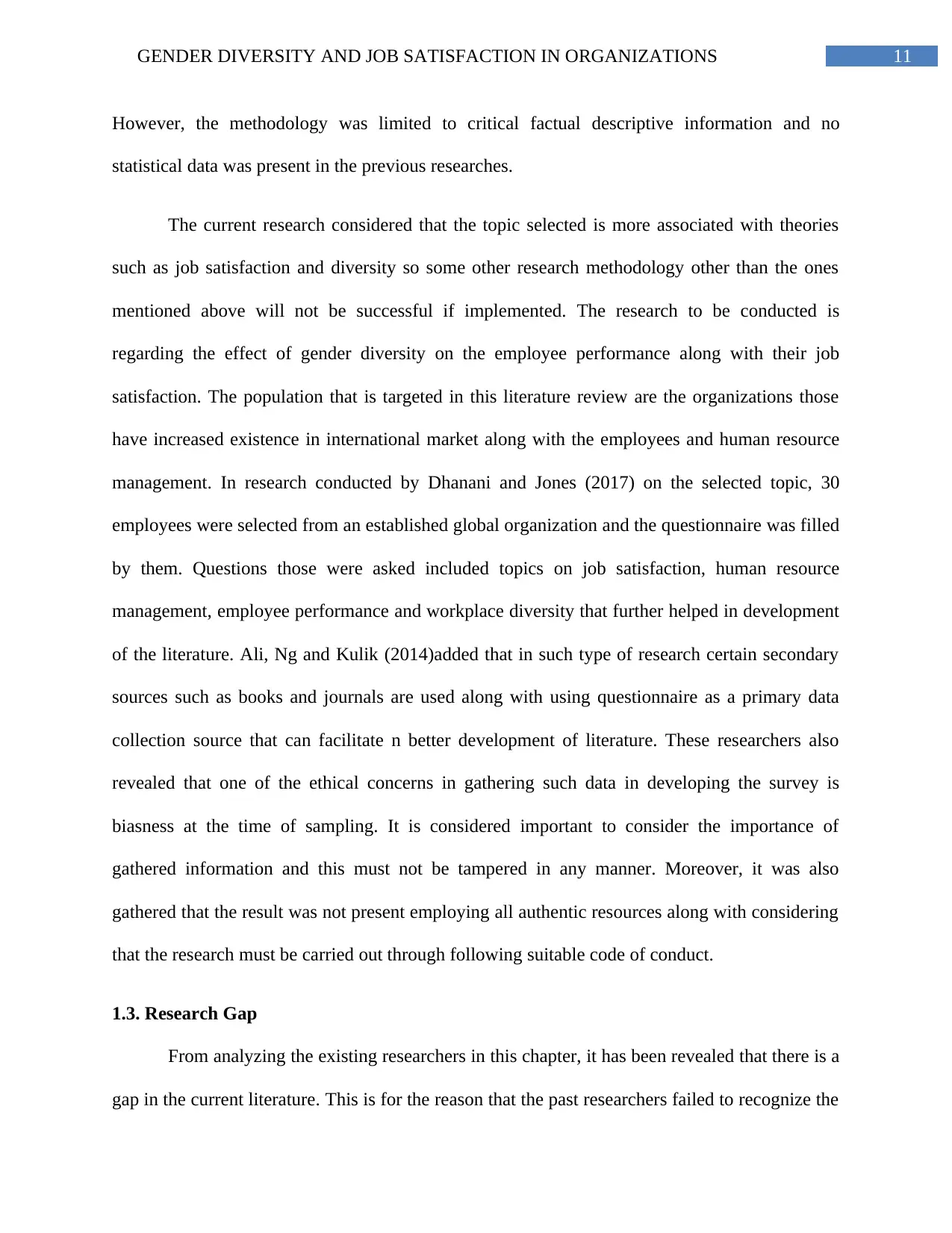
11GENDER DIVERSITY AND JOB SATISFACTION IN ORGANIZATIONS
However, the methodology was limited to critical factual descriptive information and no
statistical data was present in the previous researches.
The current research considered that the topic selected is more associated with theories
such as job satisfaction and diversity so some other research methodology other than the ones
mentioned above will not be successful if implemented. The research to be conducted is
regarding the effect of gender diversity on the employee performance along with their job
satisfaction. The population that is targeted in this literature review are the organizations those
have increased existence in international market along with the employees and human resource
management. In research conducted by Dhanani and Jones (2017) on the selected topic, 30
employees were selected from an established global organization and the questionnaire was filled
by them. Questions those were asked included topics on job satisfaction, human resource
management, employee performance and workplace diversity that further helped in development
of the literature. Ali, Ng and Kulik (2014)added that in such type of research certain secondary
sources such as books and journals are used along with using questionnaire as a primary data
collection source that can facilitate n better development of literature. These researchers also
revealed that one of the ethical concerns in gathering such data in developing the survey is
biasness at the time of sampling. It is considered important to consider the importance of
gathered information and this must not be tampered in any manner. Moreover, it was also
gathered that the result was not present employing all authentic resources along with considering
that the research must be carried out through following suitable code of conduct.
1.3. Research Gap
From analyzing the existing researchers in this chapter, it has been revealed that there is a
gap in the current literature. This is for the reason that the past researchers failed to recognize the
However, the methodology was limited to critical factual descriptive information and no
statistical data was present in the previous researches.
The current research considered that the topic selected is more associated with theories
such as job satisfaction and diversity so some other research methodology other than the ones
mentioned above will not be successful if implemented. The research to be conducted is
regarding the effect of gender diversity on the employee performance along with their job
satisfaction. The population that is targeted in this literature review are the organizations those
have increased existence in international market along with the employees and human resource
management. In research conducted by Dhanani and Jones (2017) on the selected topic, 30
employees were selected from an established global organization and the questionnaire was filled
by them. Questions those were asked included topics on job satisfaction, human resource
management, employee performance and workplace diversity that further helped in development
of the literature. Ali, Ng and Kulik (2014)added that in such type of research certain secondary
sources such as books and journals are used along with using questionnaire as a primary data
collection source that can facilitate n better development of literature. These researchers also
revealed that one of the ethical concerns in gathering such data in developing the survey is
biasness at the time of sampling. It is considered important to consider the importance of
gathered information and this must not be tampered in any manner. Moreover, it was also
gathered that the result was not present employing all authentic resources along with considering
that the research must be carried out through following suitable code of conduct.
1.3. Research Gap
From analyzing the existing researchers in this chapter, it has been revealed that there is a
gap in the current literature. This is for the reason that the past researchers failed to recognize the
⊘ This is a preview!⊘
Do you want full access?
Subscribe today to unlock all pages.

Trusted by 1+ million students worldwide
1 out of 22
Related Documents
Your All-in-One AI-Powered Toolkit for Academic Success.
+13062052269
info@desklib.com
Available 24*7 on WhatsApp / Email
![[object Object]](/_next/static/media/star-bottom.7253800d.svg)
Unlock your academic potential
Copyright © 2020–2025 A2Z Services. All Rights Reserved. Developed and managed by ZUCOL.





